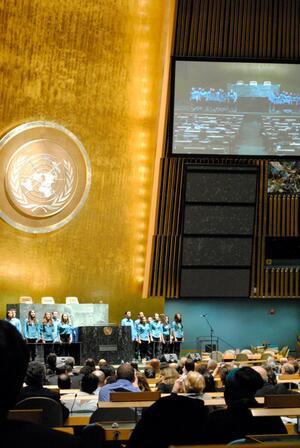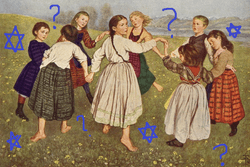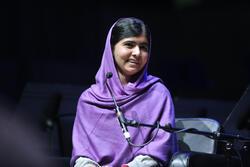Dare to Dance Together: 1940, 2011, and Today
Tony nominated playwright Elizabeth Swados raised our consciousness; she opened our eyes and dared us all to dance. Swados gave much to the world: theater, the gift of herself, one who constantly seeks truth and justice, and a strong female leader. Liz Swados also impacted my life in a very personal way- she taught me the meaning of community.
Merriam Webster’s Dictionary defines community as:
A) A unified body of individuals sharing common interests.
B) An interacting population of various kinds of individuals in a common location.
When I was twelve, I became part of an incredible community - New York teenagers performing Liz Swados’ production, Sosua: Dare to Dance Together: a musical telling the story of the Jews in the Dominican Republic during World War II. This production toured for two years, and then evolved into the documentary film, Sosua: Make a Better World.
When I first auditioned in 2011, I was aware of my own connection to the stage. I knew this connection lied in a deep inner passion of mine for the theater, but I didn’t know it came from a historical connection as well. Our cast was comprised of ten Jewish teenagers and ten Dominican teenagers, whose hearts were filled with song and grit. Together, we told two stories: the story of the Dominican Republic in World War II, and our own stories of Jewish and Dominican teenage actors coexisting in New York City. We told a story about Shoah survivors, broken but alive. We told a story of Haitians in need. But above all, we told a story of community, and Swados was our guide, directing us from above, to share our truths.
In July of 2013, an intern from JWA, Miriam Cantor Stone, watched the Sosua documentary and it made her question the way she saw the Dominican Republic and the way she saw the Shoah. Her subsequent blog post successfully captures the complexity of the situation concerning the Haitian genocide in the Dominican Republic, and the little-known story about Jews who were offered citizenship in the Dominican Republic and were therefore saved from the Holocaust.
In her piece, Miriam remarks on the incredible nature of theater and its transformative effect on performers. As one of the teenage cast members of Sosua, I feel it necessary to expand upon Miriam Cantor Stone’s points. Sosua gave me something much larger than the self-confidence one receives from performing; it enabled me to go back in time, to learn about a landmark moment for my Jewish community, and then to reflect on my life and what it means to live openly and easily as a white Jew in today’s society. Although Miriam encapsulated the essence of the historical production in her post, she did not, and could not, fully capture the experiences of those working in the performance, telling their own stories to add to the historic drama.
Although Sosua taught me a lot about myself, the experience was really one of community, for the survivors of the Shoah, and for me. Sosua was about building a new life for a new community of German-Jewish survivors alongside their Dominican neighbors in 1940; and about building a community of Jewish and Dominican teens over sixty years later. Miriam’s experience is limited to that of an audience member; she captured a piece of the experience, and I thank her for that, but she couldn’t possibly understand what it meant to be a cast member in this very special production. Referring to her own experience with theater, she states: “theatre gave me self-confidence and taught me the importance of community, and it’s clear that the teens involved in Sosúa learned the same.” Miriam clearly writes from her perspective, as she brought in her own background, but Miriam's theater experience doesn’t begin to approach what it was like to be a part of this production.
My story was not about confidence-building or about independent personal growth; it’s about community-building - a new community with ten Jewish and ten Dominican kids, who would never have met each other and shared their own personal journeys with one another if not for Liz Swados. It is the story of coexistence; of being very different and daring to dance together, not simply “daring to dance.”
Additionally, although Miriam’s post describes Swados’ tremendous accomplishments on stage, the post does not go into detail about Liz Swados’ true legacy, which is far greater than her extensive accolades. She helped to create a new image for Jewish women in theater. Swados fully owned her Jewish identity and gave bold, powerful Jewish ladies like herself, necessary time in the spotlight. Most directors, producers and writers on Broadway are predominantly male, and while the theater industry has been no stranger to the Jews, the Broadway playwriting community has yet to experience another undaunted Jewish feminist talent take center stage, since Liz Swados.
Liz Swados’ work taught me a tremendous amount about my own identity; my religion, my privilege, but most importantly, she helped me define community. For the Jewish refugees and Dominican civilians, community was “an interacting population of various individuals in a common location.” For the Jewish and Dominican teens in Washington Heights, community was “a unified body of individuals sharing common interests.” But regardless of which Miriam defines community (Miriam Cantor-Stone or Miriam Webster), for me and for Liz, community is the unified action of daring to dance together.
I only interacted with Swados a handful of times during the Sosua production, but she provided me with this experience that I’ll never forget. Swados’ production Dare to Dance Together was pivotal in my understanding of who I am as a Jew. The Make a Better World film challenged JWA intern Miriam Canter-Stone as she reflected upon her own experience watching the film, and reminiscing on her childhood acting endeavors. But most importantly, Elizabeth Swados (1951-2016) inspired young Jewish women like Canter-Stone and myself to re-evaluate consciousness, and how we approach Jewish history and the role of empowered women on stage.
This piece was written as part of JWA’s Rising Voices Fellowship.







